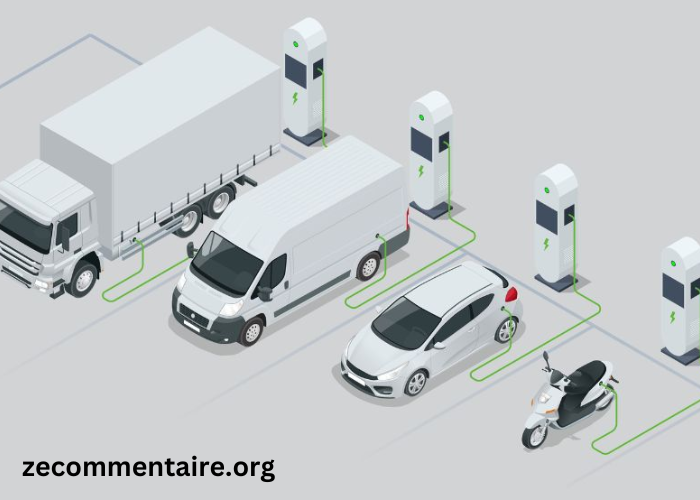The automotive industry is experiencing a significant shift towards electrification. As part of this transition, many organizations are considering the adoption of electric vehicle (EV) fleets. This move aligns with sustainability goals and offers potential cost savings and operational efficiency. Implementing fleet EV charging solutions is critical in making this transition smooth and efficient. Organizations need to understand the nuances of EV fleet management to make informed decisions and harness the full potential of their investment. Let’s dive into the benefits, challenges, and practical solutions related to EV fleets.
Benefits of EV Fleets
Transitioning to an electric vehicle fleet presents several intrinsic benefits. Firstly, EVs typically have lower long-term operational costs than their internal combustion engine (ICE) counterparts. This is due to reduced fuel costs, as electricity is often cheaper than gasoline or diesel, and fewer mechanical issues over the vehicle’s lifetime—EVs have fewer moving parts, which results in less wear and tear. Additionally, the positive environmental impact of EVs. Since EVs produce zero tailpipe emissions, they help significantly reduce air pollution, contributing to better public health and lower healthcare costs. Furthermore, transitioning to EVs reduces dependence on fossil fuels, promoting energy independence and security.
Infrastructure and Charging Solutions
Implementing an efficient charging infrastructure is paramount for the success of an EV fleet. Companies must consider public and private charging options to ensure their fleets remain operational without significant downtime. A well-planned charging infrastructure can dramatically improve the efficiency and cost-effectiveness of an EV fleet.
Private Charging Solutions
Private charging stations can be tailored to the specific needs of an organization’s fleet. This often involves installing charging stations at company premises or strategic locations where vehicles can recharge during off-peak hours. Although the initial setup cost for private charging infrastructure can be substantial, the long-term benefits often outweigh this investment. Reduced reliance on public charging stations can lead to lower operational costs and enhanced control over fleet management. Some organizations also opt for smart charging solutions that optimize energy use and minimize costs by charging vehicles during low electricity demand.
Public Charging Infrastructure
Public charging stations are essential for fleet operations that extend beyond a confined geographic area. This infrastructure is steadily growing, with more stations installed in urban areas and along major transportation routes. Among the advantages of public charging networks are their accessibility and convenience, which ensure that fleet vehicles can complete their routes without running out of power. Public charging can also support intercity and interstate travel, making it feasible for fleets to operate longer distances. Collaborations with charging network providers sometimes offer fleet operators preferential rates and services.
Challenges in Implementing EV Fleets
While the advantages of EV fleets are compelling, there are challenges to be mindful of. The initial cost of purchasing EVs can be higher than that of traditional vehicles due to the advanced battery technology and other high-tech components. However, government subsidies and tax incentives often mitigate this financial barrier, making EVs more accessible to businesses. Adequate charging infrastructure is crucial but can be costly and complex to install. Organizations must consider the logistics of installing charging stations, including space requirements and integration with existing electrical systems. Another challenge is the vehicle range limitations; fleet operators need to plan routes and schedules carefully to ensure EVs can complete their tasks without running out of charge. This may involve strategically placing charging stations or using vehicles with longer ranges for more demanding routes.
Strategies for Overcoming Challenges
To effectively tackle the challenges associated with EV fleets, there are several strategies organizations can employ:
- Comprehensive Planning: Understanding the fleet’s specific needs and operational patterns can guide the selection of appropriate EV models and charging infrastructure.
- Engage with Experts: Working with industry experts and conducting pilot programs can help identify potential issues and solutions before full-scale implementation. Leveraging expertise ensures that all aspects of the transition, from vehicle selection to charging infrastructure, are optimally managed.
- Government Incentives: Using available government subsidies and tax incentives can reduce the financial burden of transitioning to an EV fleet. These incentives can make the initial investment more manageable and enhance the overall return on investment.
- Technology Integration: Employing fleet management software can optimize routing, scheduling, and charging to ensure maximum efficiency and cost-effectiveness. Advanced analytics can help continuously improve fleet operations.
Engaging with industry experts and conducting pilot programs can help identify potential issues and trial solutions before a full-scale implementation. Moreover, leveraging available government incentives can significantly reduce the financial burden of adopting EV fleets.
Future Trends in EV Fleet Technology
As EV technology evolves, future trends point towards more efficient and sustainable fleet solutions. Advancements in battery technology promise increased vehicle range and faster charging times, which can help further alleviate range anxiety and operational interruptions. Developments in solid-state batteries and other innovative storage solutions are particularly promising for extending the range and improving safety. Autonomous electric vehicles are also on the horizon, potentially transforming fleet management by reducing labor costs and increasing safety. Combining artificial intelligence (AI) and machine learning can result in more intelligent fleet management, proactive maintenance, and improved route planning and scheduling. Being updated on these trends can assist organizations in safeguarding their fleet investments for the future. Investment in research and development and collaboration with technological innovators can provide a competitive edge in the evolving landscape of EV fleets.
Conclusion
Embracing the shift to electric vehicle fleets offers numerous benefits, from cost savings to environmental impact. While there are challenges to address, strategic planning and awareness of available solutions can pave the way for a successful transition. By learning from industry examples and staying updated with technological advancements, organizations can make well-informed decisions that align with their sustainability objectives and operational requirements. Ultimately, the transition to EV fleets represents a pivotal step towards a more sustainable and economically viable future for the transportation and logistics sectors.





